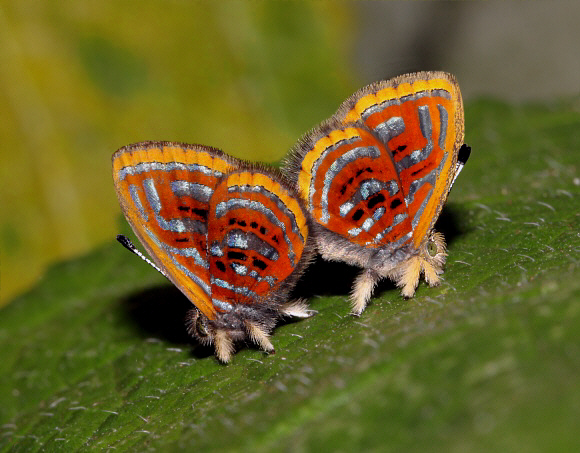 Sarota gyas, Satipo, Peru – Adrian Hoskins
Sarota gyas, Satipo, Peru – Adrian Hoskins
Introduction
The Sarota Jewelmarks are possibly the cutest butterflies in the world. They have a very rapid and erratic flight. When seen buzzing about in the early morning they can easily be mistaken for small flies. Eventually they settle however and reveal themselves as creatures of exquisite beauty, with bright orange undersides streaked with metallic silver; and cute little furry legs !
The genus Sarota was reviewed in 1998 by Jason Hall, who recognises a total of 20 species, found variously from Mexico to Bolivia, with the highest concentration in Ecuador. It has been estimated that certain locations along the base of the eastern Andes each hold up to 15 species. Most of them are extremely rare and elusive – so much so that only that even the most experienced observers rarely manage to see more than half a dozen species in a lifetime.
Both sexes of all Sarota species are characterised by having dull blackish or brownish uppersides which in some species are marked with suffused whitish spots. The undersides are reddish orange, marked with metallic silver streaks and lines, small black spots, and yellow margins. Other Sarota characteristics include disproportionately long antennae in relation to wing size, and furry legs.
Identifying the individual species is fraught with difficulty, as there are only minor differences in the patterns of several species that often fly together in the same area. Furthermore there is altitudinal, geographical and individual variation between adults of any given species. Sarota gyas can easily be confused with acantus, myrtea and miranda, but can be distinguished from them by comparing the configuration of the silver / black markings, the wing shape, and the colour of the forelegs. In gyas males the forelegs are cream, whereas in other species they are blackish.
Sarota gyas is distributed from Colombia to Peru and south west Brazil ( Mato Grosso ).
Habitats
Most Sarota species found in rainforest habitats below 1000m, although at least one is found as high as 1700m in the eastern Andes. Sarota gyas is found at altitudes between 0-800m. Populations are highly localised – often limited to a tiny corner of a forest.
Lifecycle
Females oviposit on mosses and liverworts ( Lejuniaceae ) that grow as epiphytes on old leaves of various understorey shrubs. The tiny eggs are white, globular and pitted like a sponge. The larvae when fully grown are protected by dense coat of whitish setae. If a larva is molested by an ant the setae break off and become lodged in the ant’s mandibles, preventing attack. Larvae feed solitarily, and rest underneath leaves. The pupa is formed within a rolled leaf, lined with loose hairs.
Adult behaviour
Males perch in small groups on low vegetation at forest edges or along streams, and are normally only seen between about 0630 – 0830hrs. They often rest for long periods, but there are periodic bursts of activity, typically instigated by the intrusion of a fly or another Sarota. All such intruders are aggressively challenged, Often several Sarota males will become engaged in a frenetic aerial dog-fight, spiralling upwards and zigzagging low over the ground before returning to their original perching places. Sometimes males of several Sarota species will perch in the same corner of a glade to await passing females.
When at rest, both sexes normally hold their wings erect, but very slightly apart. They do however occasionally bask with the wings held half open, if conditions are warm but slightly overcast.
Both sexes sometimes nectar at Croton or Alibertia, and have been recorded visiting extrafloral nectaries of plants in the families Araceae, Fabaceae and Tiliaceae.
